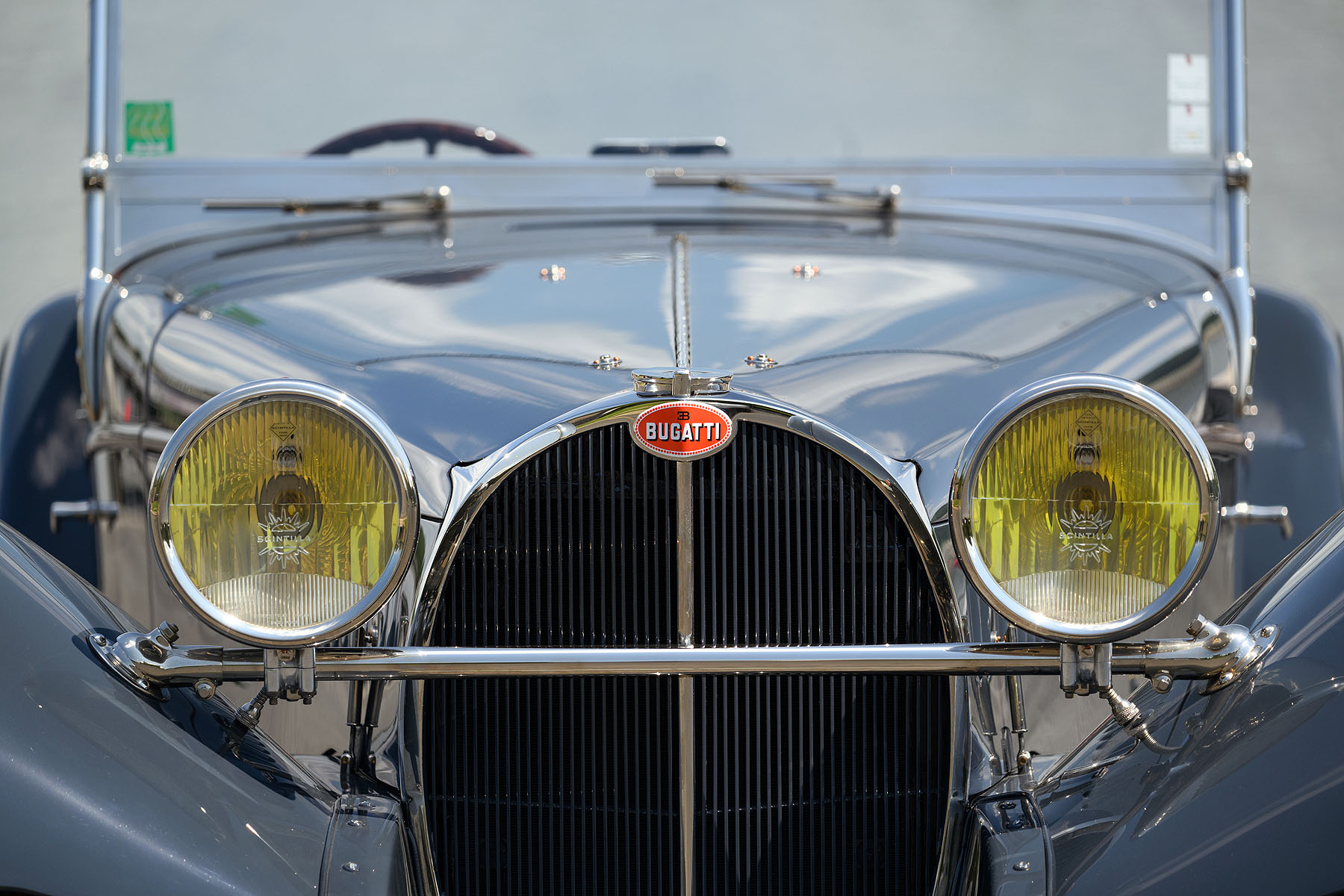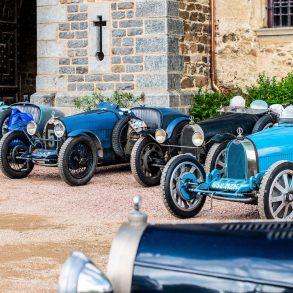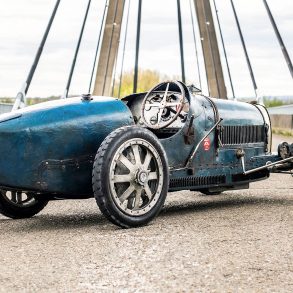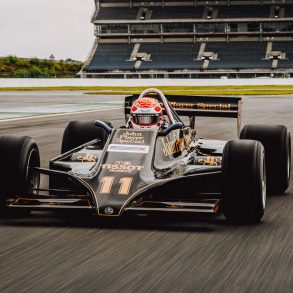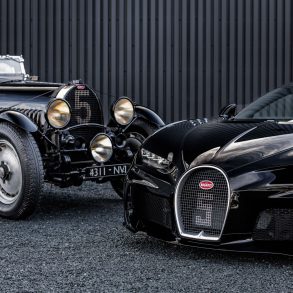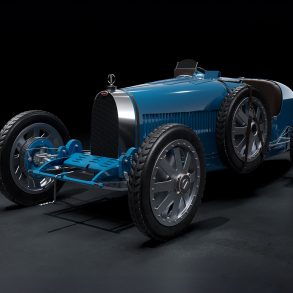Now available: Bugatti Chassis no. 57541 Engine no. 29S Body no. 3595
THE BUGATTI TYPE 57S AND SC
Bugatti’s line of “super sport” competition road models began with the superb Type 43 that was replaced by the legendary T55 and the concept would reach its zenith with Type 57S, where the S stood for surbaissé, or lowered – virtually a Grand Prix car in touring car guise. Offered as a competition sports car it was intended for use in events like the 24hrs of Le Mans – at which Bugatti would score two victories with the 57S-based “tanks”. Although the 57S shared a few features with its progenitor, the differences between the two models placed the 57S in a league of its own. The lowered stance required fitting a special crankcase with dry sump lubrication derived from the T59 GP car, including separate scavenge and pressure oil pumps supplied from a 20-liter tank. High compression pistons and special camshafts gave the new engine a significant performance edge, and the clutch a dual plate unit to cope with the extra output. Ignition was by a Scintilla Vertex magneto driven from the left-hand camshaft. With its low weight, abundant power and small frontal area, the 57S suddenly became a very, very fast automobile.
Vehicle highlights:
-
3,257cc DOHC Supercharged 8-Cylinder Engine Stromberg Carburetor and Roots-type Supercharger 200bhp at 4,500rpm
-
4-Speed Manual Transmission Low-slung Leaf Spring Suspension 4-Wheel Hydraulic Drum Brakes
-
Original New York Delivery
-
Concours, Award-Winning Restoration
-
One-off Vanden Plas Sports Tourer coachwork
-
Original Coachwork and Fully Numbers Matching
-
A collector car that ticks all the boxes
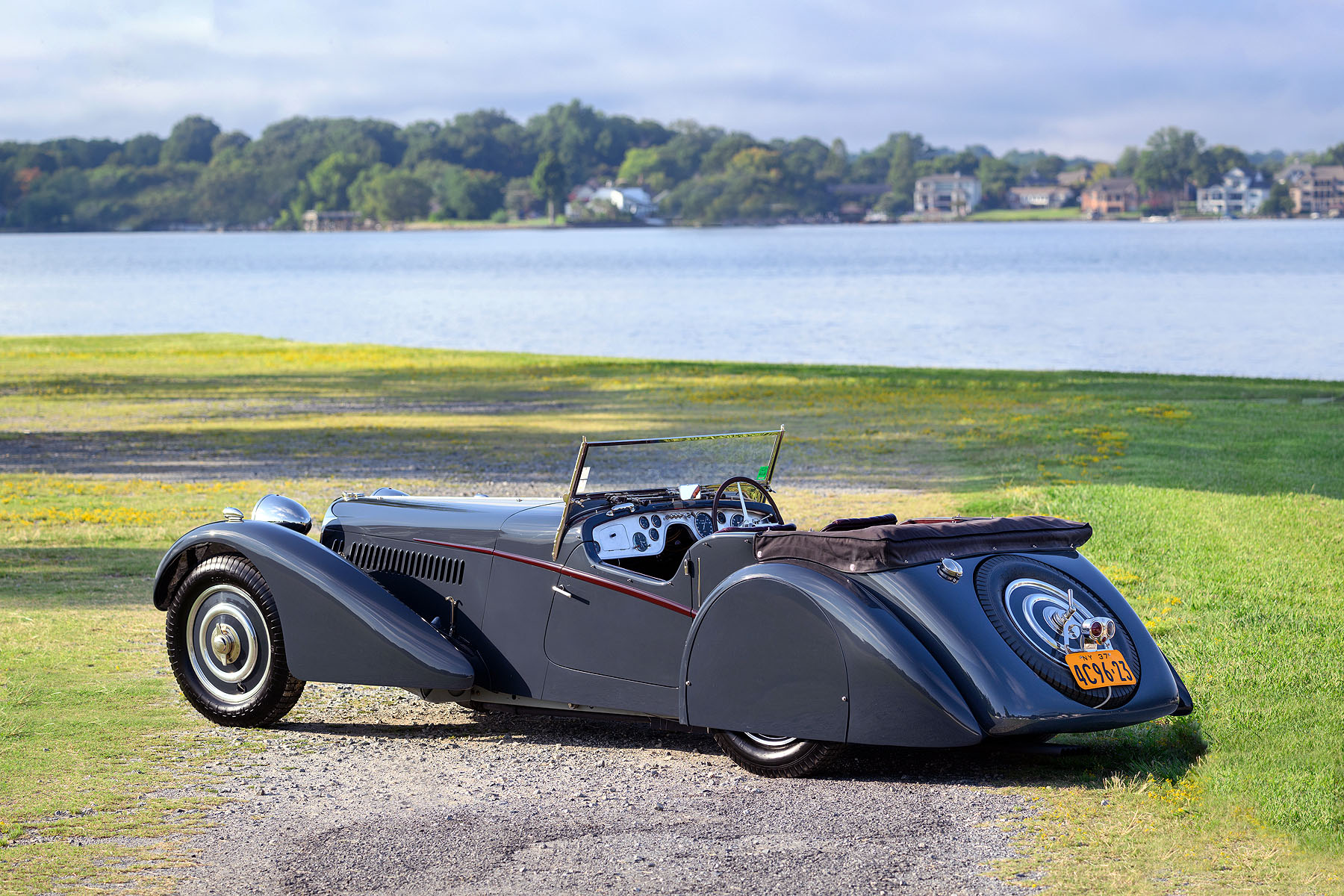
RAREST OF THE RARE
Even rarer than the Type 57S chassis that were bodied with Bugatti factory designs built by Gangloff in Colmar, were the very few that were handed over to outside coachbuilders. The car offered here is one of these ultimately rare cars. The Carrosserie Van den Plas was incorporated in Brussels in 1898. Automobile body manufacture commenced in 1900, and the company grew quickly. From about 1906, Metallurgique cars with Van den Plas bodies were imported into England by a company called Warwick Wright, which acquired the license to manufacture Van den Plas bodies and designs for the United Kingdom in 1910. In 1913, Vanden Plas (in two words) Ltd. was incorporated which then became a coachbuilding company in its own right.
The two companies led separate lives but co-existed peacefully over the years. From 1924 to 1931, the English Vanden Plas company became famous for its rakish bodies on W.O. Bentley chassis, of which about 700 were built. With its reputation for quality coachwork well-established, Vanden Plas also bodied a number of Alvis, Armstrong Siddeley, Bentley, Daimler, Lagonda, and Rolls-Royce chassis in the 1930s. Vanden Plas bodied a total of two Type 57S chassis, namely the subject car and chassis 57572 which was given two- seater cabriolet coachwork in the autumn of 1937.
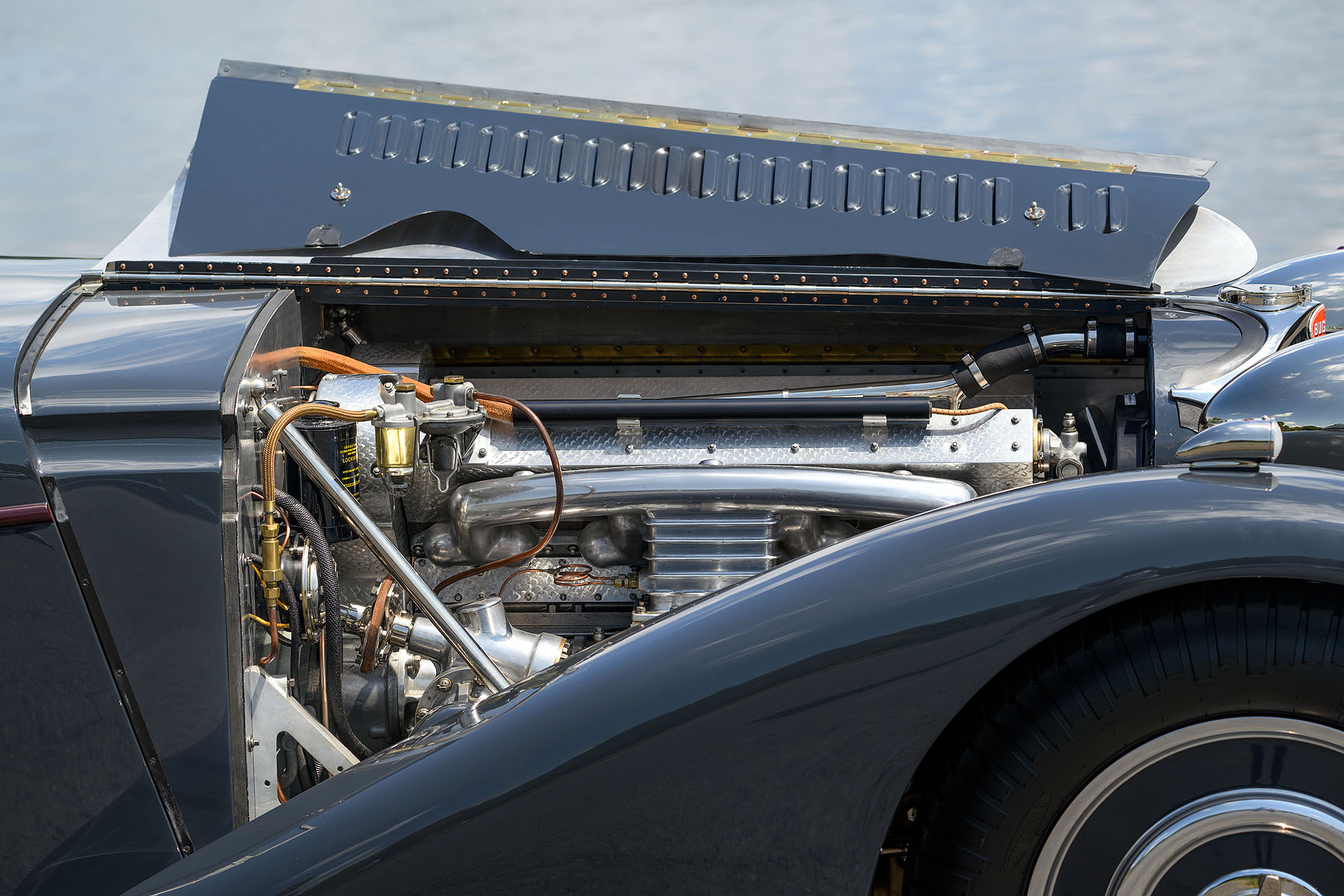
THE MOTORCAR OFFERED
The history of 57541 described here relies on the work of Bugatti expert Pierre-Yves Laugier, as well as on that of Bernhard Simon and Julius Kruta. All three have published chassis-by-chassis accounts of the Type 57S, which have been used. Factory records indicate 57541 was ordered by Colonel Sorel, the London agent on Brixton Road. The chassis was sent to Vanden Plas and given a four-seat touring-roadster body no. 3595. Painted gray with red accents, the cost of this exquisite bolide was £275. Interestingly the Vanden Plan records state the coachwork as being ordered by Ettore Bugatti.
Bodied in the classic minimalistic British style with sporting cut-down doors, 57541 resembles the Vanden Plas 4 1/4-liter Bentley Tourer body no. 3340 delivered to Malcolm Campbell in April 1936, as well as the 4.3-liter short chassis Alvis body no. 3588 built in 1937. Historically and stylistically, these three bodies can trace their lineage directly back to the great Vanden Plas-bodied W.O. Bentleys from the late 1920s. In this period a body with four-seats was mandatory for events like the 24 hours of Le Mans and the most minimal, light weight seat was fitted to this sports tourer. It has the clever feature of being hinged and of light alloy construction to allow instant access to the rear brakes, axles and batteries. Colonel Sorel must have been justifiably happy with the result, as 57541 was pictured in the company’s 1937-1938 catalog.
George Rand and Samuel Collier, US Bugatti importers had 57541 shipped to New York where it is likely that it was used at the A.R.C.A. races on September 25, 1937. Period images exist of the car taken at the Roosevelt Raceway race in New York without the fender skirts it was fitted with initially. Rand was unable to find a buyer for the car, and it was shipped back to England and shown on the Bugatti stand at the London Motor Show held at the Olympia from October 13 to 22, 1938.

DISAPPEARED INTO THIN AIR
57541 vanished from sight during the hostilities, but towards the end of the war, it appeared for sale at the Continental Cars garage which was owned by Rodney Clarke, and it is likely that it was given registration number DXP 970 in 1947. That same year, the car had no less than three owners, namely Rodney Clarke, Brian Finglass, and Sir Alfred McAlpine, all of whom were managers of Continental Cars. Using Jack Bartlett as intermediary, they sold 57541 to Jack Robinson, who exported it to Trinidad, where it was registered as PB 371.
According to Pierre-Yves Laugier, Robinson stated in a 1952 issue of Bugantics that when he bought the car through Bartlett, it was equipped with a Type 35B 3-blade racing supercharger. Robinson also noted that major work had been done to the car including fitting a new crankshaft, crankcase, cylinder block, pistons and connecting rods. In 1952, the car was completely overhauled, but its original gray color was kept.
Robinson kept 57541 for more than thirty years and sold it to Peter Agg in 1985, with Leonard Potter possibly acting as middle- man. Via his Trojan company, Agg undertook a complete restoration of the car. The engine was given to Crosthwaite and Gardner, who replaced the 35B supercharger with a correct Type 57 unit, thereby bringing 57541 up to factory correct 57SC specification. Hydraulic brakes were fitted and the car was repainted in the light metallic blue color that it wears today.
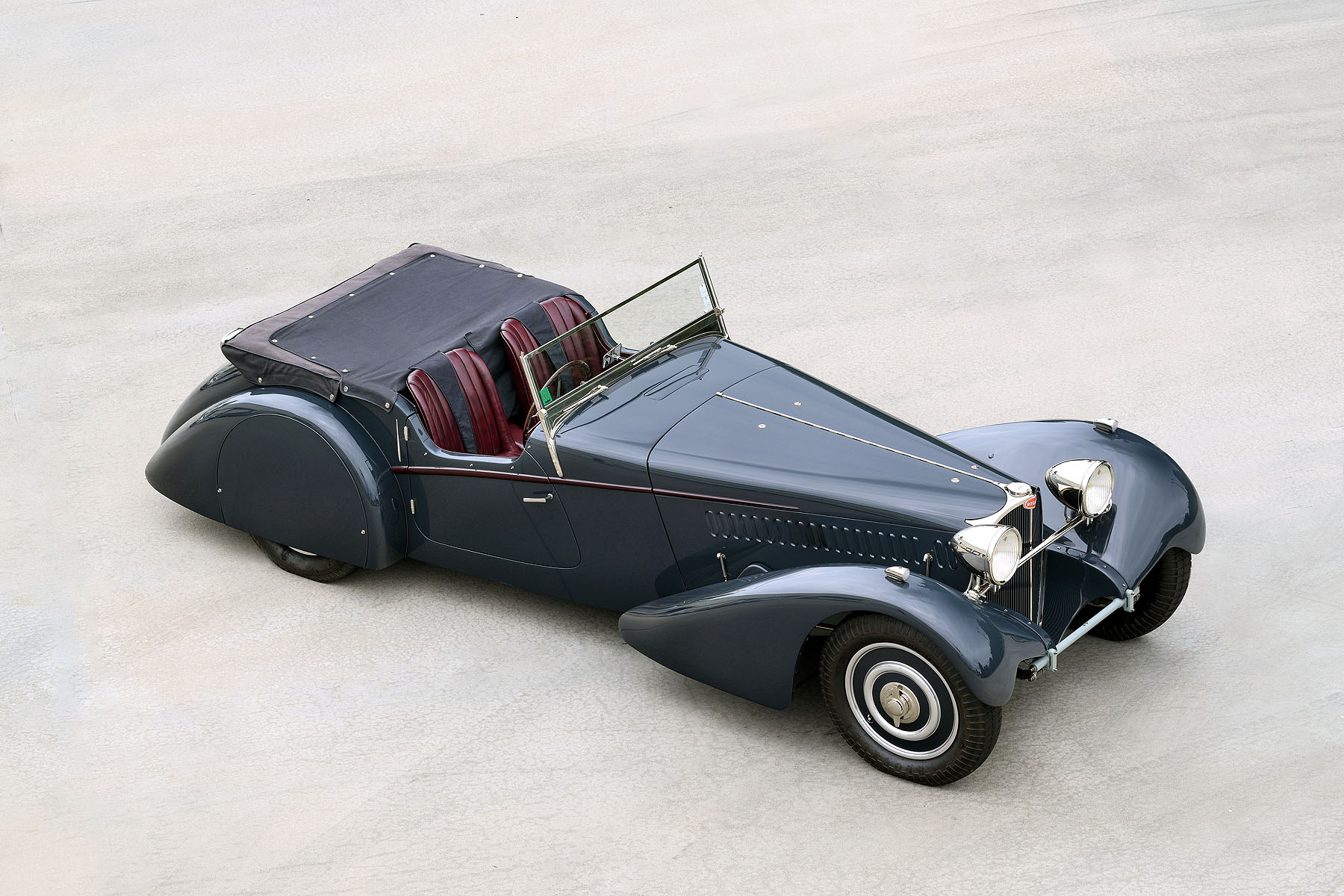
THE RESTORATION OF 57541
As purchased and carefully reviewed, 57541 was a very proper and correct car that had suffered from an insensitive 1980s restoration. The goal was to reverse this work and make the originality front and center with a heavily researched and sensitive refurbishment appropriate to a car of its stature. Many of these valuable Type 57S cars have been thoroughly restored and much of the original “hands of the makers” are erased it in an effort for artificial perfection.
The philosophical guidelines for the restoration were:
-
Bring the car back to its original delivery configuration, with original crank case. Bring the wonderful subtlety back to the body work that had been lost through poor repairs.
-
Use all the original body metal, replace only the smallest damaged areas if necessary.
-
Use original materials and techniques particularly period pant and fabrics.
-
Locate original Molshiem hardware to replace any modern fasteners and hardware.
-
Paint the car its original colors in nitrocellulose lacquer paint. Leave any factory hand work and tooling marks visible.
-
Use cotton-based material as original for canvas parts.
-
Do not embellish anything – it should be as good but no better than it left the factory.
-
Use all original engine turned surfaces and polish only what the factory polished (engine block in particular).
-
Have the car be fully usable for any rally event and be in unmodified factory form.
A tremendous amount of research was done to find out exactly how this car was configured as new and every effort was made to get the smallest detail correct. The bodywork, despite a clean, simple appearance has wonderful complexity in the details. In particular, features such as the stunning fenders that through years of minor parking damage and old repairs had their beauty compromised, were returned to their original lines. A large effort was made rebuilding the edges of the fenders to bring back these wonderful styling details that visually lower the car and give it a feeling of motion. The backs of the rear fenders – a vulnerable spot when backing up were nearly 4” higher than when the car was built. The car also received the correct wheel spats and the proper disc-wheel covers it had when new.

PERFORMANCE
Also, when it comes to road performance, such an important aspect of these cars, with no modifications mechanically it drives like it should – an absolute beast of a car but with beautifully direct and light handling. With nearly 200hp and only a little over 2000lbs of car it gives up nothing to its most potent contemporaries.
SUMMARY
Since 57541 has received numerous awards at Pebble Beach, Amelia Island, Audrain Newport Concours, and a recipient of Best Restoration at the Villa D’Este Concours d’Elegance. And, it is certainly no ‘trailer queen’ the 57S has spent many miles of on the road unleashing its thrilling performance. Remarkably, 57541 has a virtually unbroken chain of protective owners who have taken extremely good care of this automotive jewel since it left the factory. Factor in the unbeatable combination of its unique coach-built body and genuine 1930s supercar underpinnings, and the result is truly a heady cocktail. The Bugatti Type 57S embodies the highest standards in road holding, engineering refinement and maximum performance in a prewar car. It also displays a sheer mechanical elegance that is the very pinnacle of m
AUCTION ESTIMATE
Available at Bonhams Amelia Island Auction, the estimated sell prices is $10,000,000 – 12,000,000
Special formalities are required to bid on this lot. Contact Client Services at +1 (212) 644 9001 or bids.us@bonhams.com at least 24 hours in advance of the auction for registration and bidding options.


